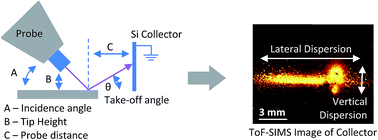Visualizing mass transport in desorption electrospray ionization using time-of-flight secondary ion mass spectrometry: a look at the geometric configuration of the spray†
Abstract
Time-of-flight secondary ion mass spectrometry (ToF-SIMS) was used to visualize the transport of analyte molecules desorbed onto a silicon wafer collection substrate by desorption electrospray ionization (DESI). The effect of spray incidence angle, tip height, and probe distance on the concentration and the spatial distribution of desorbed analyte molecules were investigated with the objective of identifying DESI operational parameters that provide more reproducible results by achieving steady ion transmission and minimized material loss. An incidence angle between 25° and 35° with respect to the plane of the surface provided the best compromise between maximizing ambient MS signal and achieving the best reliability. Glancing incidence angles provided higher ambient MS signals through a tighter dispersion of the secondary droplet plume, but run-to-run variability of as much as 40%. On the other hand, steeper incidence angles led to a widening of the lateral dispersion of the secondary droplets and decreased analyte desorption. For all incidence angles, shorter probe distances were preferred since the resulting tighter dispersion of the secondary droplets produced higher ion transmission and therefore higher ambient MS signals. Tip height was found to correlate with the spot size (footprint) of the spray on the surface; changing the tip height from (1 to 2 to 3) mm changed the diameter of the spray impact area from (1.3, 1.8, to 2.1) mm, respectively. For shorter probe to MS inlet distances, larger tip heights increased the ambient MS signal due to increased analyte desorption while maintaining a tighter dispersion of the secondary droplet plume. Equally important to optimizing instrument configuration was the understanding that the deposition of a sample onto the surface resulted in a coffee ring, where the diameter was larger than the spot size of the spray. Higher tip heights may be preferred for a more consistent analyte response since all or a large fraction of the analyte could be sampled to reduce variability in ambient MS response. The study showed that ToF-SIMS can be used as a unique tool for characterizing the transport of desorbed analyte molecules for DESI, and potentially offers insight into new interface designs for improved transmission of analyte into the mass spectrometer.


 Please wait while we load your content...
Please wait while we load your content...